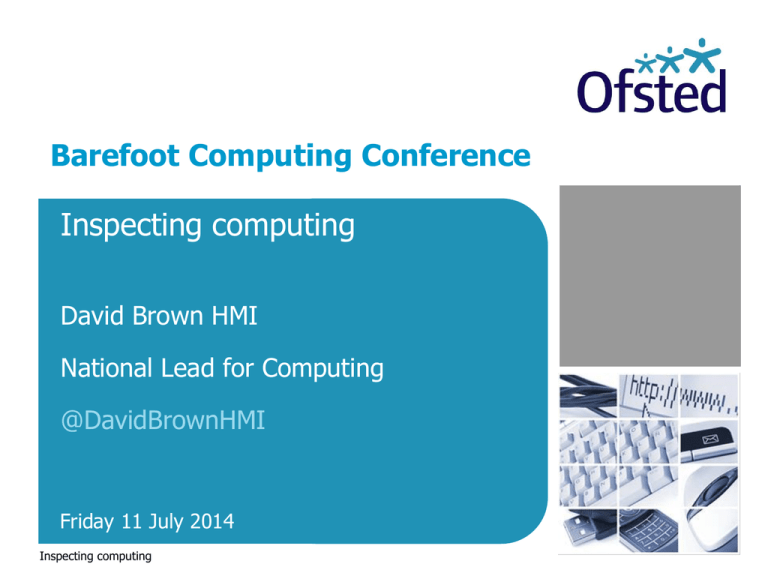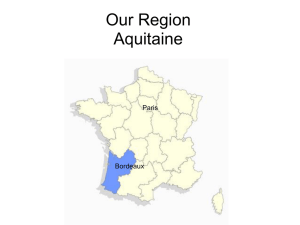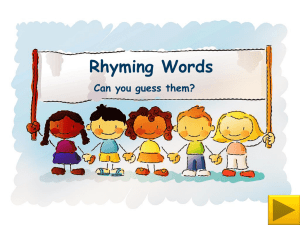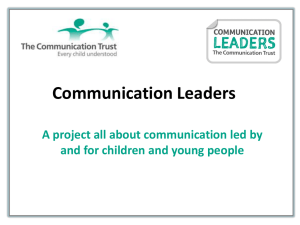
Barefoot Computing Conference
Inspecting computing
David Brown HMI
National Lead for Computing
@DavidBrownHMI
Friday 11 July 2014
Inspecting computing
Computing
The final programmes of study for computing for Key
Stages 1-4 were published in September 2013. Maintained
schools in England are legally required to follow this
statutory national curriculum from September 2014.
The national curriculum sets out in programmes of study,
on the basis of key stages, subject content for those
subjects that should be taught to all pupils.
Every state-funded school must offer a curriculum which is
balanced and broadly based and which promotes the
spiritual, moral, cultural, mental and physical development
of pupils at the school and of society, and prepares pupils
at the school for the opportunities, responsibilities and
experiences of later life.
Inspecting computing
Computing
The school curriculum comprises all learning and other
experiences that each school plans for its pupils. The
national curriculum forms one part of the school
curriculum. Inspectors see a range of curricula across
maintained schools, academies and free schools. Schools
develop their own curriculum to respond to the particular
needs of their pupils and ensure they receive a broad and
balanced education. However, a school’s curriculum must
comply with the legislation to give pupils the opportunity
to study a wide range of subjects.
Academies are also required to offer a broad and
balanced curriculum in accordance with Section 1 of the
2010 Academies Act.
All schools must publish their school curriculum by subject
and academic year online; there is a legal requirement to
make curriculum information available on a school’s
website.
Inspecting computing
Computing
The computing curriculum can be considered as built from
three strands:
Computer science: the scientific and practical study of
computation; what can be computed, how to compute it,
and how computation may be applied to the solution of
problems.
Information technology: concerned with how
computers and telecommunications equipment work, and
how they may be applied to the storage, retrieval,
transmission and manipulation of data.
Digital literacy: the ability to effectively, responsibly,
safely and critically navigate, evaluate and create digital
artefacts using a range of digital technologies.
Inspecting computing
School inspection
School inspection
The School inspection handbook explains how
inspections are conducted and the judgements that are
made by inspectors. It contains the grade descriptors
used by inspectors when making their judgements.
The Framework for school inspection sets out the
statutory basis for section 5 inspections.
A regularly updated Subsidiary guidance document is
provided to support inspection.
Inspecting computing
Evaluating the curriculum (extract)
The School inspection handbook (paragraph 140) states that
inspectors should consider how well leaders and managers
ensure that the curriculum:
is broad and balanced (in the context of the school) and
meets the needs, aptitudes and interest of pupils
including, if applicable, pupils in the sixth form
promotes high levels of achievement and good behaviour
is based at Key Stage 4 on an appropriate balance
between academic and vocational courses.
is effectively planned and taught
does not compromise pupils’ achievement, success or
progression by inappropriately early entry to public
examinations
Inspecting computing
Evaluating the curriculum (extract)
Subsidiary guidance (paragraph 120) states that:
When considering whether the curriculum has sufficient
breadth and balance and the extent to which it meets the
needs, aptitudes and interests of pupils, inspectors should
note the following:
A curriculum with breadth and balance in maintained
schools is likely to consist of the national curriculum
subjects, religious education (RE) and a variety of other
courses and programmes, including extra-curricular and
enhancement activities offered by the school and its
partners. Where a school does not provide the national
curriculum and RE, inspectors will need to fully explore
the school’s reasons. For academies, inspectors should
check the curriculum requirements set out in the
academy’s funding agreement.
Inspecting computing
Evaluating achievement (extract)
Achievement is outstanding when
pupils make rapid and sustained progress throughout
year groups across many subjects, including English and
mathematics, and learn exceptionally well.
the achievement of pupils for whom the pupil premium
provides support at least matches that of other pupils in
the school or has risen rapidly, including in English and
mathematics
pupils develop and apply a wide range of skills to great
effect in reading, writing, communication and
mathematics; they are exceptionally well prepared for the
next stage in their education, training or employment
pupils, including those in the sixth form and those in the
Early Years Foundation Stage, acquire knowledge quickly
and develop their understanding rapidly in a wide range
of different subjects across the curriculum
Inspecting computing
Evaluating achievement (extract)
Achievement is outstanding when
the learning of groups of pupils, particularly those who
are disabled, those who have special educational needs,
those for whom the pupil premium provides support, and
the most able is consistently good or better
the standards of attainment of almost all groups of pupils
are likely to be at least in line with national averages with
many pupils attaining above this. In exceptional
circumstances, an outstanding grade can be awarded
where standards of attainment of any group of pupils are
below those of all pupils nationally, but the gap is closing
rapidly, as shown by trends in a range of attainment
indicators.
Inspecting computing
Use of assessment information
As now, inspectors will use a range of evidence to make
judgements, including by looking at test results, pupils’ work
and pupils’ own perceptions of their learning. Inspectors will
not expect to see a particular assessment system in place and
will recognise that schools are still working towards full
implementation of their preferred approach. However,
inspectors will:
spend more time looking at the range of pupils’ work to
consider what progress they are making in different areas
of the curriculum
talk to leaders about schools’ use of formative and
summative assessment and how this improves teaching
and raises achievement
evaluate how well pupils are doing against relevant agerelated expectations as set out by the school and the
national curriculum
Inspecting computing
Use of assessment information
consider how schools use assessment information to
identify pupils who are falling behind in their learning or
who need additional support to reach their full potential,
including the most able
evaluate the way schools report to parents and carers on
pupils’ progress and attainment and assess whether
reports help parents to understand how their children are
doing in relation to the standards expected.
Inspecting computing
Inspection of computing
Achievement in computing
Achievement in computing is good or better when
pupils demonstrate excellent understanding of important
concepts in all three strands of the computing curriculum
and are able to make connections within the subject
because they have highly developed transferable
knowledge, skills and understanding
pupils consistently use their subject knowledge and
understanding very effectively in written and verbal
explanations and can solve challenging problems
pupils make highly effective use of a wide range of
hardware and software appropriate to their age and
ability
Inspecting computing
Achievement in computing
Achievement in computing is good or better when
pupils show independence in their use of computing
across all three strands of the curriculum and exhibit
positive attitudes towards the subject and working
constructively with others
pupils show high levels of originality, imagination,
creativity and innovation in their understanding and
application of skills in computing
all secondary pupils have the opportunity to study aspects
of information technology and computer science at
sufficient depth to allow them to progress to higher levels
of study or to a professional career.
Inspecting computing
Achievement in computing
Achievement in computing is likely to be inadequate when
pupils’ lack of understanding of one or more strands of
the computing curriculum impedes their progress
pupils rarely demonstrate creativity or originality in their
use of computing but seem confined to following
instructions
pupils lack interest and enthusiasm for the subject and
cannot describe the relevance of computing in a
technological age
in secondary schools significant proportions of pupils in
Key Stage 4 neither study information technology or
computer science nor develop their skills systematically
through other subjects.
Inspecting computing
Teaching in computing
Teaching in computing is good or better when
it is informed by excellent subject knowledge and
understanding of continuing developments in teaching
and learning in computing
teachers have a high level of competence and expertise,
both in terms of their specialist knowledge and technical
skills and in their understanding of active learning in
computing, which they use effectively to secure
achievement which is at least good
it is rooted in the development of pupils’ understanding of
important concepts and progression within the lesson and
over time; it enables pupils to make connections between
individual topics and to see the ‘big picture’
Inspecting computing
Teaching in computing
Teaching in computing is good or better when
lessons address pupils’ misconceptions very effectively;
teachers’ responses to pupils’ questions are accurate and
highly effective in stimulating further thought
teachers communicate high expectations, enthusiasm and
passion about computing to pupils; they challenge and
inspire pupils to produce the best work they can
teachers use a very wide range of innovative and
imaginative resources and teaching strategies to stimulate
pupils’ active participation in their learning and secure
good or better progress across all aspects of the subject.
Inspecting computing
Teaching in computing
Teaching in computing is likely to be inadequate when
teaching fails to engage pupils in computing; lessons are
not sufficiently related to pupils’ lives and experiences
with the result that pupils do not value the subject
weaknesses and gaps in the teacher’s knowledge of
computing or how pupils learn the subject hamper lesson
planning, the choice of resources, or the quality of
teachers’ explanations, with the result that pupils make
too little progress
assessment information does not inform lesson planning
and schemes of work are not differentiated to meet the
needs of different groups of pupils
teachers’ low expectations contribute to the pupils’ poor
progress in computing
Inspecting computing
Teaching in computing
Teaching in computing is likely to be inadequate when
teaching strategies result in pupils being too passive, with
little opportunity for pupils to contribute their own
understanding and ideas in lessons
the quality of feedback is poor and teachers do not
correct common errors or misconceptions
teachers’ subject expertise is limited and does not cover
the required breadth of the three strands of the
computing curriculum.
Inspecting computing
The computing curriculum
The computing curriculum is good or better when
an imaginative and stimulating curriculum is skilfully
designed to match to the full range of pupils’ needs to
ensure highly effective continuity and progression in their
learning
the curriculum is broad and balanced with all three
computing strands covered well for all pupils, in
computing lessons and/or across the school curriculum
the contexts in which computing is taught are relevant to
pupils’ lives and reflect the increasing use of computing in
the world of industry; excellent links are forged with other
agencies and the wider community to provide a wide
range of enrichment activities to promote pupils’ learning
and engagement with the subject
links with other subjects in the school are productive in
strengthening pupils’ learning in computing
Inspecting computing
The computing curriculum
The computing curriculum is good or better when
pupils are expected to use their computing knowledge,
skills and understanding in realistic and challenging
situations
KS4 and KS5 pupils have access to a range of appropriate
qualifications in information technology and computer
science, including academic and vocational options
pupils’ have comprehensive knowledge and understanding
of how to stay safe when using new technologies
rigorous curriculum planning ensures the subject makes
an outstanding contribution to pupils’ spiritual, moral,
social and cultural development.
Inspectors will be aware that, for example, a Year 7 teacher
cannot currently assume that pupils have covered the full KS1
and KS2 computing programmes of study.
Inspecting computing
The computing curriculum
The computing curriculum is likely to be inadequate when
the curriculum does not meet the needs of significant
numbers of pupils in the school and, as a result, too many
make poor progress
the curriculum is not broad and balanced, covering all
three strands of the computing cuirriculum
significant proportions of pupils do not receive any
computing provision, either discretely or through
appropriate cross-curricular provision
there is little enrichment activity in the subject
connections between the computing experiences planned
and the lives of pupils are weak and result in low levels of
engagement and enjoyment
Inspecting computing
The computing curriculum
The computing curriculum is likely to be inadequate when
there are few links between computing and other subjects
pupils have poor knowledge and understanding of how to
stay safe when using new technologies
opportunities to promote pupils’ spiritual, moral, social
and cultural development are missed.
there are no suitable progression routes into information
technology and computer science for pupils at Key Stages
4 and 5
Inspecting computing
Leadership in computing
Leadership of computing is good or better when
leadership is informed by a high level of subject expertise
and vision which has a clear impact on the performance
and practice of members of the department and on
outcomes for pupils
there is a strong track record of innovation in computing;
subject reviews, self-evaluation and improvement
planning are well-informed by current best practice in
computing education
subject leadership inspires confidence and whole-hearted
commitment from pupils and colleagues; there are
effective strategies to delegate subject responsibilities
where appropriate and to share good practice and secure
high quality professional development in the subject
Inspecting computing
Leadership in computing
Leadership of computing is good or better when
continuing professional development is well-targeted and
thoroughly evaluated for its impact; it includes up-to-date
training for teaching assistants and technical support staff
computing has a very high profile in the life of the school
and is at the cutting edge of initiatives to raise pupil
progress
access to computing equipment is outstanding, and the
school is likely to have promoted the use of mobile
technologies; the computing infrastructure enables pupils
and staff to have very good access to their work and to
the school’s learning resources at all times, and
contributes to pupils’ achievement
Inspecting computing
Leadership
Leadership is good or better when
there is an age-appropriate e-safety curriculum that is
flexible, relevant and engages pupils’ interest; that is used
to promote e-safety through teaching pupils how to stay
safe, how to protect themselves from harm and how to
take responsibility for their own and others’ safety
e-safety is a priority across all areas of the school, with all
teaching and non-teaching staff receiving regular and upto-date training in e-safety
rigorous e-safety policies and procedures are in place,
written in plain English, contributed to by the whole
school, updated regularly and ratified by governors.
Inspecting computing
Leadership in computing
Leadership of computing is likely to be inadequate when
leadership is not well-informed about current initiatives in
the subject
there is little evidence of a broader vision of computing
education that draws on the work of other professionals
beyond the school
key statutory requirements for computing are not met
insufficient effort is made to coordinate the work of
computing staff and to improve the quality of the weakest
teachers
self-evaluation is weak and not informed by good practice
in the subject, or by outcomes for pupils
Inspecting computing
Leadership in computing
Leadership of computing is likely to be inadequate when
opportunities for professional development in the subject
are limited, and, as a result, some staff lack the
confidence and expertise to deliver computing effectively
the subject has a low profile in the life of the school, is
poorly resourced and does not contribute significantly to
whole-school improvements
pupils and staff have only limited access to computing
equipment when they need it.
Inspecting computing
Leadership
School leadership is likely to be inadequate when
there is no progressive, planned e-safety education across
the curriculum
there is little evidence of e-safety training for staff
e-safety policies are generic and not regularly updated.
The leadership and management of the school are likely to be
judged to be inadequate if:
the school’s arrangements for safeguarding pupils do not
meet statutory requirements and give serious cause for
concern.
Inspecting computing
Statutory duty
‘The governing body of a maintained school shall make
arrangements for ensuring that their functions relating to the
conduct of the school are exercised with a view to
safeguarding and promoting the welfare of children who
are pupils at the school.’
section 175 Education Act 2002
Inspecting computing
The inspection of e-safety
Inspection of e-safety
The April 2014 School inspection handbook contains the
following text:
The behaviour and safety of pupils at the school
Inspectors should consider (paragraph 135):
Types, rates and patterns of bullying and the effectiveness
of the school’s actions to prevent and tackle all forms of
bullying and harassment. This includes cyber-bullying
and prejudice-based bullying related to special educational
need, sexual orientation, sex, race, religion and belief,
gender reassignment or disability.
The school’s success in keeping pupils safe, whether
within school or during external activities through, for
instance, effective risk assessments, e-safety
arrangements, and action taken following any serious
safeguarding incident
Inspecting computing
Inspection of e-safety
The grade descriptor for outstanding includes:
Pupils are fully aware of different forms of bullying,
including cyber-bullying and prejudice-based bullying,
and actively try to prevent it from occurring. Bullying and
derogatory or aggressive language in all their forms are
rare and dealt with highly effectively.
All groups of pupils are safe and feel safe at school and at
alternative provision placements at all times. They
understand very clearly what constitutes unsafe situations
and are highly aware of how to keep themselves and
others safe in different situations, including in relation to
e-safety.
Inspecting computing
Inspection of e-safety
The April 2014 School inspection handbook contains the
following text:
The quality of leadership in, and management of, the
school
Inspectors should consider (paragraph 140):
The effectiveness of safeguarding arrangements to ensure
that there is safe recruitment and that all pupils are safe.
This includes the promotion of safe practices and a culture
of safety, including e-safety.
Inspecting computing
Inspection of e-safety
The April 2014 Subsidiary Guidance document contains the
following text (paragraph 145):
Inspectors should include e-safety in their discussions
with pupils, covering topics such as safe use of the
internet and social networking sites and cyber-bullying
including by text message, and the measures the school
takes to promote safe use and combat unsafe use.
Inspecting computing
And finally
E-safety is now considered in the inspection of all
education remits including the early years sector,
further education and skills, and initial teacher
education.
Social care inspectors also consider e-safety in the
inspection of these remits, including in boarding
and residential provision in schools and colleges,
children’s homes and adoption and fostering
services and agencies.
Inspecting computing
`
Support available
Inspecting computing
Support available
Inspecting computing
Links
Computing at School:
www.computingatschool.org.uk
Naace: www.naace.co.uk
Child Exploitation and Online Protection Centre
(CEOP): ceop.police.uk
UK Safer Internet Centre: www.saferinternet.org.uk
UK Council for Child Internet Safety (UKCCIS):
www.education.gov.uk/ukccis
Childnet International: www.childnet.com
www.ofsted.gov.uk
@DavidBrownHMI
Inspecting computing
`
Barefoot Computing Conference
Inspecting computing
David Brown HMI
National Lead for Computing
@DavidBrownHMI
Friday 11 July 2014
Inspecting computing


![afl_mat[1]](http://s2.studylib.net/store/data/005387843_1-8371eaaba182de7da429cb4369cd28fc-300x300.png)





